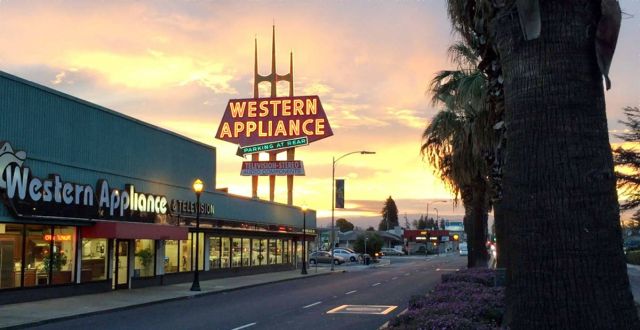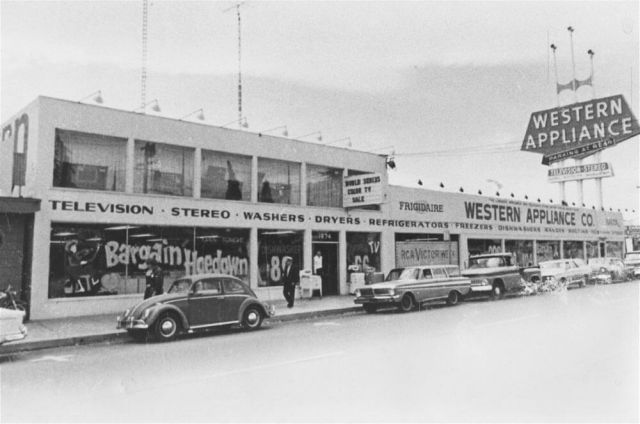
Will a Tower of Historic Neon Disappear?
 |
Jeffrey Niederauer has taken great pride in Western Appliance, the 146-year-old store founded by his great grandfather, Jacob, in Bakersfield, and a San Jose staple since the 1930s, which Jeffrey shuttered this spring.
Western Appliance, the only union shop in the appliance business in the nation, Niederauer says, became an integral part of the South Bay community, and so did its neon sign that could be seen for miles.
Now, preservationists are hoping to save the sign, which the San Jose Mercury News calls “probably the most iconic neon sign in Santa Clara County,” even as they regret the loss of the business.
“Now, how would San Jose feel without its majestic, one-of-a-kind Western Appliance sign?” writes Heather David, of the San Jose Sign Project, which promotes vintage signs.
“Some would argue that the Western Appliance sign is OUR Hollywood sign, OUR Welcome to Las Vegas sign, an endearing and lasting cultural place marker, by any definition. We sure hope that the City of San Jose understands this.”
“The position of the San Jose Signs Project is that the Western Appliance Sign become a city landmark, be restored to its original splendor, and remain in place,” she writes.
 |
The sign was installed in 1962 and originally had three blinking balls atop the three spires. To make things even merrier, the arrow pointing to parking was animated! The sign is at 1976 W. San Carlos Street. It was produced by the Electrical Products Corporation, Heather determined after much investigation.
“The sign is not currently turned on,” Niederauer says. “We do not have a baseline for how expensive it is to power it, so I can't say what we will be doing in the future yet.”
The sign was recognized as an important example of Googie design in a document prepared in 2009 for the city’s Redevelopment Agency and the Preservation Action Council of San Jose, the 'San Jose Modernism Historical Context Statement.'
“Googie describes buildings constructed using futurist architectural elements, designed to address the automobile culture that proliferated during the era of suburbanization,” historians with PAST Consultants wrote. “In a new age charted by the automobile and fueled by unprecedented levels of consumerism, the striking forms of Googie architecture served their purpose well.”
The section featured a photo of the Western Appliance tower, which was called a “futuristic road sign.”
 |
Niederauer, director of operations and of marketing, cites lower margins due to competition from big box stores and direct sales by manufacturers as one reason for closing. The store announced it would close for good in January, long before the COVID pandemic. It closed its doors in April after making its final deliveries.
About two dozen people were working there, down from 180 a decade or so ago when Western Appliance operated ten stores, Niederauer says.
“It being part of my family’s legacy was a big part behind my joining in the first place,” says Niederauer, 41, whose background is in tech and education. He has helped run the store for 15 years.
“I appreciate how respected we were in the community and in the industry. And, honestly, part of the reason we decided to close is, we weren’t able to provide the service that should be given at the profit margins” that were possible.
“We use a consultative sales approach with people to figure out the best match for them. We have to pay for that type of talent.”
Niederauer, who owns the store’s site, says he would like to find a buyer for the land, or a partner in its development, who would keep the sign. “I’m trying to find people open to integrating it or preserving it,” he says.
 |
He tells potential developers that preservationists will fight to save the sign, as they fought to save the nearby Century 21 domed cinemas.
“I tell people approaching me about it there’s one thing you have to be aware of. Everybody goes ga-ga for that sign,” Niederauer says.
Niederauer has gotten to know Heather David, and people at the Neon Museum in Glendale, and even attended a neon sign conference. “I enjoy it. I appreciate it,” he says of neon signage. He points out, though, that maintenance and repairs are costly.
“Fifty years from now, if there’s a sign that reads ‘Western Appliance,’ what will it mean 50 years from now? If it could be picked up and moved, which it cannot, then no question I would send it anywhere that wants to take it,” he says.
“I also wonder. The zoning here allows up to five or six stories tall, so the grandeur it currently has would be dwarfed by the new zoning regulations. Now it’s up against a single-story building. What would it look like against a five- or six-story one?”
- ‹ previous
- 657 of 677
- next ›



